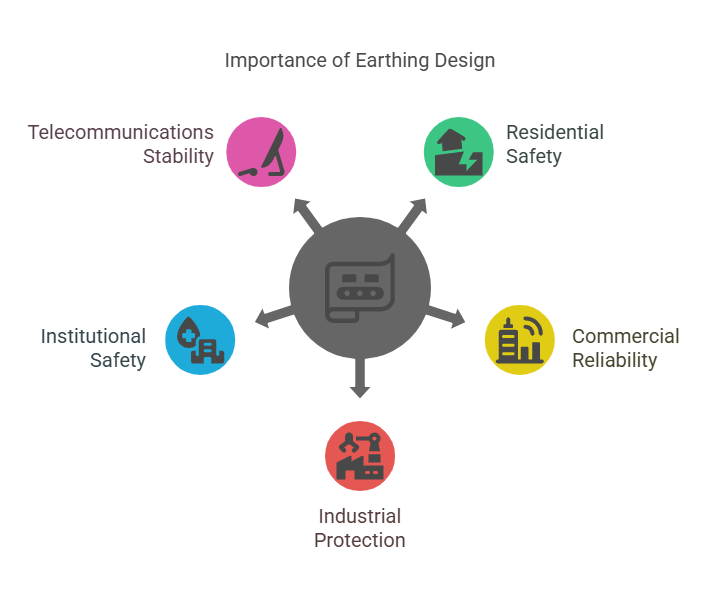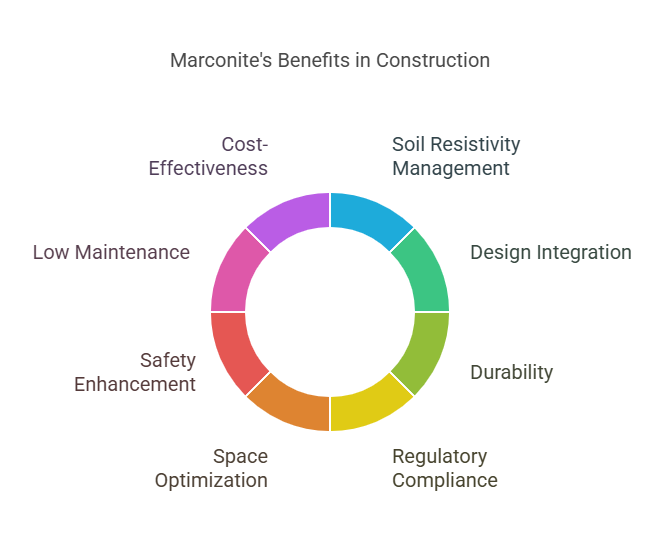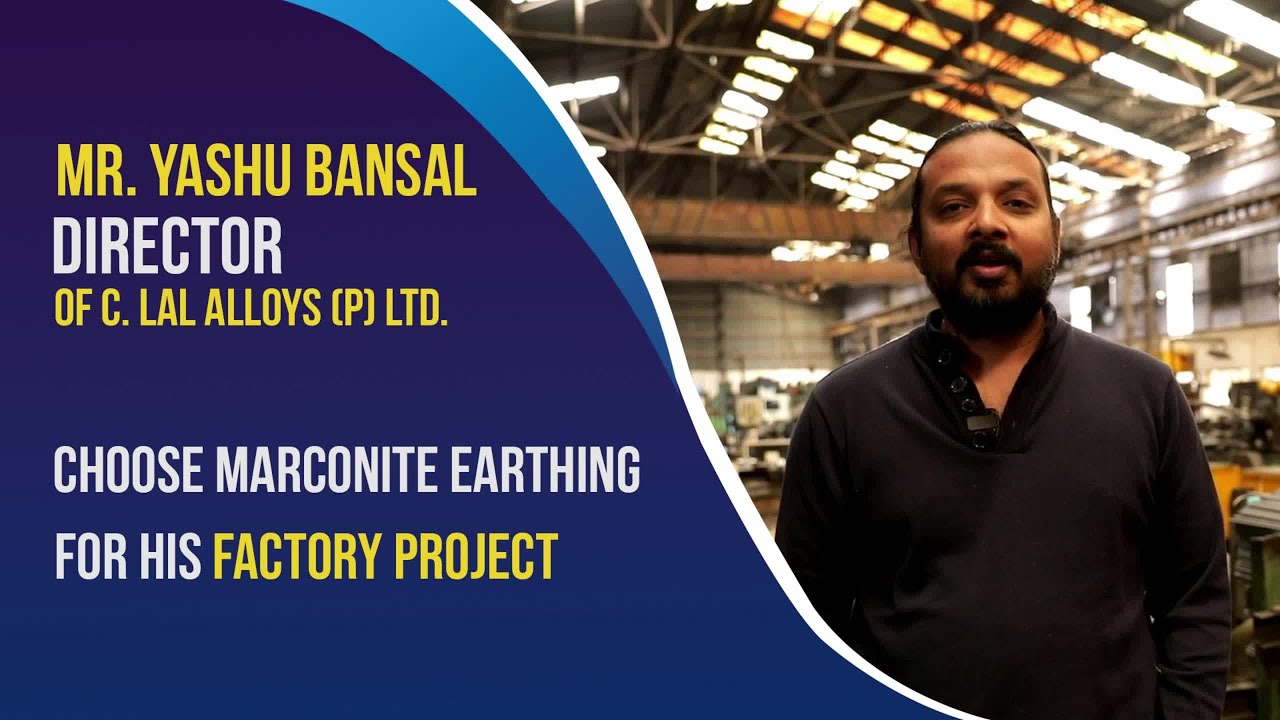Introduction: Earthing Designing in Construction Projects
In construction projects, a well-designed earthing or grounding system is crucial for keeping everything safe and working properly. Detailed earthing drawings, including grounding electrodes and connections, are crucial for stabilizing voltage levels and meeting safety standards.
Proper earthing ensures a secure path for fault currents, preventing electric shocks and protecting equipment.
Importance of Earthing Designing in Construction Projects
Safety and Electrical Functioning
In construction projects, electrical systems are crucial, so safety is key. Faults or surges can cause serious accidents or damage. Proper earthing or grounding design ensures that excess electrical energy is safely redirected to the ground, reducing the risk of electric shock and equipment failure.
Emphasizing the Need for Earthing Design
A well-planned earthing or grounding design is essential across different types of construction projects to ensure safety and system reliability. It adapts to specific needs and environments, protecting both people and equipment.
Earthing design is crucial for various types of buildings and projects:

Residential Projects
In residential construction, proper earthing or grounding is crucial for protecting occupants from electrical faults and ensuring safe appliance operation. It directs fault currents to the ground, reducing electric shock risks and preventing potential fire hazards, thus enhancing overall safety and reliability.
Commercial Projects
In offices and retail spaces, a robust earthing design is crucial for protecting employees and valuable equipment from electrical disturbances. Effective earthing mitigates risks to sensitive electronics and ensures staff safety by providing a reliable fault current path. It also helps maintain operational continuity, reducing downtime from electrical faults or equipment failures.
Industrial Projects
In industrial settings with heavy machinery, effective earthing or grounding is essential for protecting personnel and ensuring safe equipment operation. Due to high electrical loads and complex systems, a well-designed Earthing system handles significant fault currents and prevents equipment damage. This robust earthing design safeguards workers from electrical hazards and enhances machinery reliability, boosting overall operational efficiency.
Institutional Buildings
Hospitals and schools need meticulous earthing or grounding designs to safeguard students, patients, and staff. Effective earthing is vital in these settings to guard against electrical hazards and ensure that essential systems operate reliably. For hospitals, precise earthing prevents malfunctions in life-support equipment, while schools require reliable earthing to ensure safe electrical installations and a secure learning environment.
Telecommunications Infrastructure
Earthing is crucial in telecommunications to reduce electromagnetic interference (EMI) and ensure reliable network performance. Proper earthing or grounding keeps sensitive equipment free from external electrical noise, improving data transmission and system stability. A stable grounding system enhances signal integrity and supports uninterrupted communication services.
Methods of Earthing Systems
- Plate Earthing: Plate earthing involves embedding a metal plate (commonly copper or galvanized iron) in the ground. The plate is typically buried vertically or horizontally and connected to the electrical system through a conductor. This method provides a large surface area for grounding, making it effective in areas with moderate soil resistivity.
- Pipe Earthing: Pipe earthing uses a long metal pipe (often made of galvanized iron or copper) that is driven into the earth. The pipe serves as the grounding electrode, and a connection is made from the electrical system to the top of the pipe. This system is particularly suitable for locations where soil resistivity is high and other methods might not be effective.
-
Rod Earthing: Rod earthing involves driving a metal rod (usually copper or galvanized iron) vertically into the ground to serve as the grounding electrode. The electrical system is connected to the rod, which provides a reliable path for fault currents to be safely dissipated into the earth. This method is effective in areas with low to moderate soil resistivity.
-
Strip Earthing: Strip earthing employs a metal strip (copper or galvanized iron) laid horizontally in a trench, buried several inches below the ground. The strip acts as a large surface area grounding electrode, providing an effective grounding in various soil conditions, especially in industrial and commercial installations with higher grounding requirements.
How Marconite is helpful across types of Earthing Systems
Marconite’s advanced properties make it a valuable material for enhancing various earthing or grounding systems. Its high conductivity, low resistivity, and durability contribute to improved performance and safety across all types of earthing TN-S, TN-C, TN-C-S, TT, and IT systems, addressing specific challenges and optimizing earthing design in diverse applications.
The TN-S, TN-C, TN-C-S, TT, and IT systems refer to different types of electrical earthing (or grounding) systems, while Plate Earthing, Pipe Earthing, Rod Earthing, Strip Earthing, and Earthing through Water Pipe are methods of implementing these earthing systems.
TN-S System
The TN-S (Terra Neutral Separate) system, featuring separate neutral and earth conductors throughout the installation, is widely used in construction projects for its robust safety and reliability. Marconite’s superior electrical conductivity and low resistivity offer significant benefits for this system. By incorporating Marconite into the earthing electrodes, the TN-S system achieves lower earthing resistance, which enhances fault current dissipation. This improvement stabilizes voltage levels, reducing the risk of electric shock and interference, and ensures a safer, more reliable earthing system for both residential and commercial applications.
TN-C System
The TN-C (Terra Neutral Combined) system, which combines neutral and earth functions into a single Protective Earth Neutral (PEN) conductor, benefits greatly from Marconite’s high conductivity. By using Marconite, the performance of the PEN conductor is significantly improved, as it maintains low resistance and effectively handles fault currents. This enhancement reduces the risk of electrical faults and ensures that the combined conductor performs optimally, addressing safety concerns related to merging neutral and earth functions.
TN-C-S System
In the TN-C-S (Terra Neutral Combined-Separate) system, Marconite earthing or grounding enhances both the combined and separated sections of the system. Marconite’s high conductivity supports efficient fault current management in the initial combined section, while its durability and low resistance improve performance at separation points. This combination provides a balanced solution that enhances safety and reliability while maintaining cost-efficiency, making it ideal for modern installations requiring both effective distribution and protection.
TT System
The TT (Terra Terra) system, where each installation has its own independent earthing electrode, greatly benefits from Marconite’s properties. Marconite’s high conductivity ensures each electrode provides optimal grounding performance, even in areas with poor natural earth conditions. Its resilience to environmental factors and minimal maintenance needs further improve the reliability of the TT system, reducing electrical hazards and ensuring long-term safety and effectiveness.
IT System
The IT (Isolated Terra) system, which requires effective isolation and continuous monitoring, leverages Marconite’s low resistivity and stable conductivity. Marconite supports reliable fault management in isolated systems, crucial for environments like hospitals or data centres where uninterrupted power is essential. Its durability ensures the earthing system remains effective over time, supporting high-reliability operations and enhanced safety in critical applications.
The choice of earthing system depends on specific construction project requirements, regulations, and environmental conditions. Marconite can be used with any of these earthing systems to optimize their performance in construction projects.
How Marconite Solves Earthing Designing Challenges in Construction Projects
In construction projects, incorporating a Marconite earthing system can significantly address various earthing or grounding design challenges and enhance overall project safety and efficiency. Here’s how Marconite benefits construction projects in specific aspects of earthing design:

-
Effective Soil Resistivity Management:
Low Resistance Across Diverse Soil Types: In construction projects, Maronite’s high electrical conductivity ensures that the earthing system performs effectively even in soils with high resistivity, such as rocky or gravelly conditions. This adaptability is crucial for achieving low resistance in challenging soil environments commonly encountered on construction sites.
-
Simplified Design Integration:
Versatile and Adaptable Installation: Marconite’s flexibility and ease of installation make it ideal for integrating into various construction designs. Whether incorporating earthing or grounding systems into new builds or retrofitting existing structures, Marconite facilitates seamless integration, simplifying the design and installation processes in complex construction projects.
-
Durability Against Environmental Factors:
Corrosion and Degradation Resistance: Construction projects often expose earthing systems to harsh environmental conditions. Marconite’s resistance to corrosion and environmental degradation ensures that the earthing system remains reliable and effective over time, even in challenging conditions such as high moisture or chemical exposure.
-
Compliance with Regulatory Standards:
Meeting Safety and Building Codes: In construction projects, ensuring compliance with electrical standards and building codes is essential. Marconite earthing systems are designed to meet stringent safety regulations, helping construction projects adhere to necessary standards and reducing the risk of non-compliance.
-
Optimized for Space Constraints:
Effective Use of Limited Space: Construction sites, particularly in urban or densely built areas, often face space constraints. Marconite’s high conductivity allows for more compact earthing configurations, making it easier to implement effective earthing or grounding solutions in restricted spaces without compromising performance.
-
Enhanced Safety:
Minimizing Electrical Shock Risks: Ensuring the safety of construction personnel and future occupants is a top priority. Marconite’s superior conductivity ensures that fault currents are quickly and safely directed to the ground, minimizing the risk of electrical shocks and enhancing overall safety on construction sites.
-
Low Maintenance and Long-Term Reliability:
Reduced Maintenance Needs: The durability of Marconite reduces the frequency of maintenance required for the earthing system. This long-term reliability is particularly valuable in construction projects, where ongoing maintenance costs and system performance are critical considerations.
-
Cost-Effective Performance:
Balancing Initial Costs with Long-Term Benefits: While Marconite might involve a higher initial investment, its durability, low maintenance requirements, and superior performance often result in overall cost savings for construction projects. This makes Marconite a smart investment for achieving dependable and efficient earthing systems.
Marconite Earthing Systems
Marconite is a high-performance material that enhances the effectiveness of earthing systems. It’s known for its low resistivity, durability, and resistance to corrosion.
Top 3 Benefits of Using Marconite Earthing System:
- High Conductivity: Ensures efficient fault current dissipation, enhancing overall safety.
- Durability: Resists environmental factors and reduces maintenance needs.
- Flexibility: This can be integrated into various earthing systems to improve their performance.
Conclusion
Marconite enhances the performance of traditional earthing systems by improving conductivity and durability. It is not a replacement but a material that can be used within these systems to improve their effectiveness.
Marconite is a valuable addition to earthing systems, providing enhanced performance and reliability, but the choice between different earthing or grounding systems will depend on the specific needs of the construction project.






